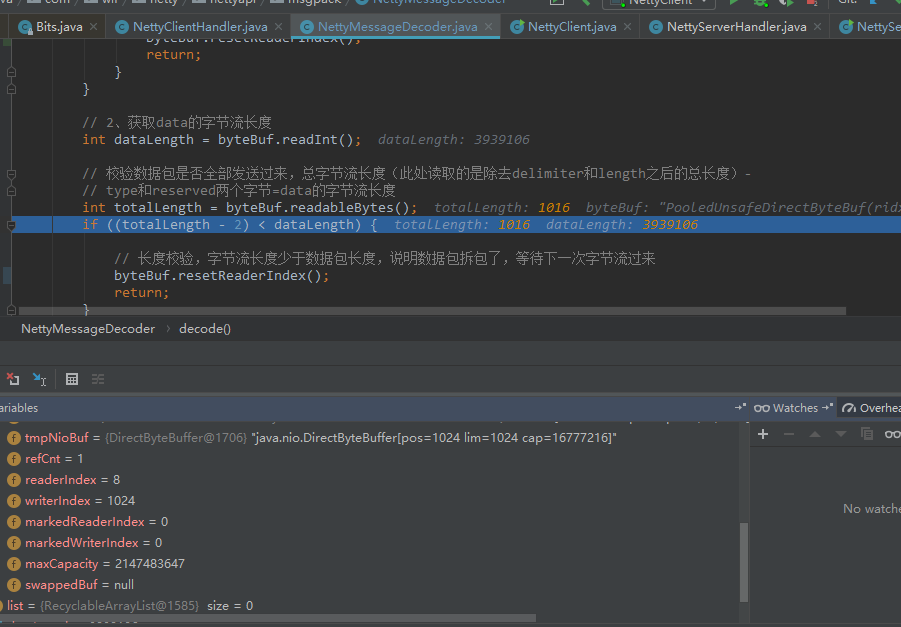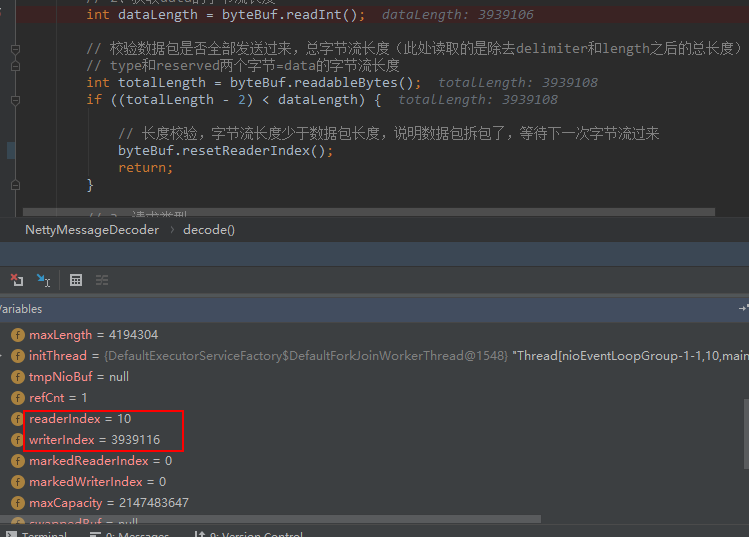之前我们有个netty5的拆包解决方案(参加netty5拆包问题解决实例),现在我们采用另一种思路,不需要新增LengthFieldBasedFrameDecoder,直接修改NettyMessageDecoder:
package com.wlf.netty.nettyapi.msgpack; import com.wlf.netty.nettyapi.constant.Delimiter; import com.wlf.netty.nettyapi.javabean.Header; import com.wlf.netty.nettyapi.javabean.NettyMessage; import io.netty.buffer.ByteBuf; import io.netty.channel.ChannelHandlerContext; import io.netty.handler.codec.ByteToMessageDecoder; import java.util.List; public class NettyMessageDecoder extends ByteToMessageDecoder { /** * 消息体字节大小:分割符字段4字节+长度字段4字节+请求类型字典1字节+预留字段1字节=10字节 */ private static final int HEAD_LENGTH = 10; @Override protected void decode(ChannelHandlerContext channelHandlerContext, ByteBuf byteBuf, List<Object> list) throws Exception { while (true) { // 标记字节流开始位置 byteBuf.markReaderIndex(); // 若读取到分割标识,说明读取当前字节流开始位置了 if (byteBuf.readInt() == Delimiter.DELIMITER) { break; } // 重置读索引为0 byteBuf.resetReaderIndex(); // 长度校验,字节流长度至少10字节,小于10字节则等待下一次字节流过来 if (byteBuf.readableBytes() < HEAD_LENGTH) { byteBuf.resetReaderIndex(); return; } } // 2、获取data的字节流长度 int dataLength = byteBuf.readInt(); // 校验数据包是否全部发送过来,总字节流长度(此处读取的是除去delimiter和length之后的总长度)- // type和reserved两个字节=data的字节流长度 int totalLength = byteBuf.readableBytes(); if ((totalLength - 2) < dataLength) { // 长度校验,字节流长度少于数据包长度,说明数据包拆包了,等待下一次字节流过来 byteBuf.resetReaderIndex(); return; } // 3、请求类型 byte type = byteBuf.readByte(); // 4、预留字段 byte reserved = byteBuf.readByte(); // 5、数据包内容 byte[] data = null; if (dataLength > 0) { data = new byte[dataLength]; byteBuf.readBytes(data); } NettyMessage nettyMessage = new NettyMessage(); Header header = new Header(); header.setDelimiter(Delimiter.DELIMITER); header.setLength(dataLength); header.setType(type); header.setReserved(reserved); nettyMessage.setHeader(header); nettyMessage.setData(data); list.add(nettyMessage); // 回收已读字节 byteBuf.discardReadBytes(); } }
我们的改动很小,只不过将原来的读索引改为标记索引,然后在拆包时退出方法前重置读索引,这样下次数据包过来,我们的读索引依然从0开始,delimiter的标记就可以读出来,而不会陷入死循环了。
ByteBuf是ByteBuffer的进化版,ByteBuffer(参见ByteBuffer使用实例)才一个索引,读写模式需要通过flip来转换,而ByteBuf有两个索引,readerIndex读索引和writerIndex写索引,读写转换无缝连接,青出于蓝而胜于蓝:
+-------------------+------------------+------------------+
| discardable bytes | readable bytes | writable bytes |
| | (CONTENT) | |
+-------------------+------------------+------------------+
| | | |
0 <= readerIndex <= writerIndex <= capacity
既然有两个索引,那么标记mask、重置reset必然也是两两对应,上面的代码中我们只需要用到读标记和读重置。
我们把客户端handler也修改下,先把LengthFieldBasedFrameDecoder去掉:
// channel.pipeline().addLast(new LengthFieldBasedFrameDecoder(1024 * 1024 * 1024, 4, 4, 2, 0));
再让数据包更大一些:
/** * 构造PCM请求消息体 * * @return */ private byte[] buildPcmData() throws Exception { byte[] resultByte = longToBytes(System.currentTimeMillis()); // 读取一个本地文件 String AUDIO_PATH = "D:\input\test_1.pcm"; try (RandomAccessFile raf = new RandomAccessFile(AUDIO_PATH, "r")) { int len = -1; byte[] content = new byte[1024]; while((len = raf.read(content)) != -1) { resultByte = addAll(resultByte, content); } } return resultByte; }
再debug下看看,第一次解析客户端发送的数据,读取1024字节,我们可以看到读索引是8(delimiter+length=8),写索引就是1024,我们的大包里有3939116个字节,去掉10个字节的header,剩下小包是3939106::

第二次再读1024,代码已经执行reset重置读索引了,所以读索引由8改为0,写索引累增到2048:

第三次再读1024,写索引继续累增到3072:

最后一次发1024,写索引已经到达3939116,大包传输结束了:

从上面看出,我们对ByteBuf的capacity一直在翻倍,读指针一直标记在大包的起始位置0,这样做的目的是每次都能读取小包的长度length(3939106),拿来跟整个ByteBuf的长度作比较,只要它取到的小包没到达到length,我们就继续接受新包,写索引不停的累加,直到整个大包长度>=3939116(也就是小包>=3939106),这时我们开始移动读索引,将字节流写入对象,最后回收已读取的字节(调用discardReaderBytes方法):
BEFORE discardReadBytes()
+-------------------+------------------+------------------+
| discardable bytes | readable bytes | writable bytes |
+-------------------+------------------+------------------+
| | | |
0 <= readerIndex <= writerIndex <= capacity
AFTER discardReadBytes()
+------------------+--------------------------------------+
| readable bytes | writable bytes (got more space) |
+------------------+--------------------------------------+
| | |
readerIndex (0) <= writerIndex (decreased) <= capacity
其他方法参见测试类:
package com.wlf.netty.nettyserver; import io.netty.buffer.ByteBuf; import io.netty.buffer.Unpooled; import org.junit.Assert; import org.junit.Test; public class ByteBufTest { @Test public void byteBufTest() { ByteBuf byteBuf = Unpooled.buffer(10); byteBuf.writeInt(0xabef0101); byteBuf.writeInt(1024); byteBuf.writeByte((byte) 1); byteBuf.writeByte((byte) 0); // 开始读取 printDelimiter(byteBuf); printLength(byteBuf); // 派生一个ByteBuf,取剩下2个字节,但读索引不动 ByteBuf duplicatBuf = byteBuf.duplicate(); printByteBuf(byteBuf); // 派生一个ByteBuf,取剩下2个字节,读索引动了 ByteBuf sliceBuf = byteBuf.readSlice(2); printByteBuf(byteBuf); // 两个派生的对象其实是一样的 Assert.assertEquals(duplicatBuf, sliceBuf); } private void printDelimiter(ByteBuf buf) { int newDelimiter = buf.readInt(); System.out.printf("delimeter: %s ", Integer.toHexString(newDelimiter)); printByteBuf(buf); } private void printLength(ByteBuf buf) { int length = buf.readInt(); System.out.printf("length: %d ", length); printByteBuf(buf); } private void printByteBuf(ByteBuf buf) { System.out.printf("reader Index: %d, writer Index: %d, capacity: %d ", buf.readerIndex(), buf.writerIndex(), buf.capacity()); } }
输出:
delimeter: abef0101 reader Index: 4, writer Index: 10, capacity: 10 length: 1024 reader Index: 8, writer Index: 10, capacity: 10 reader Index: 8, writer Index: 10, capacity: 10 reader Index: 10, writer Index: 10, capacity: 10